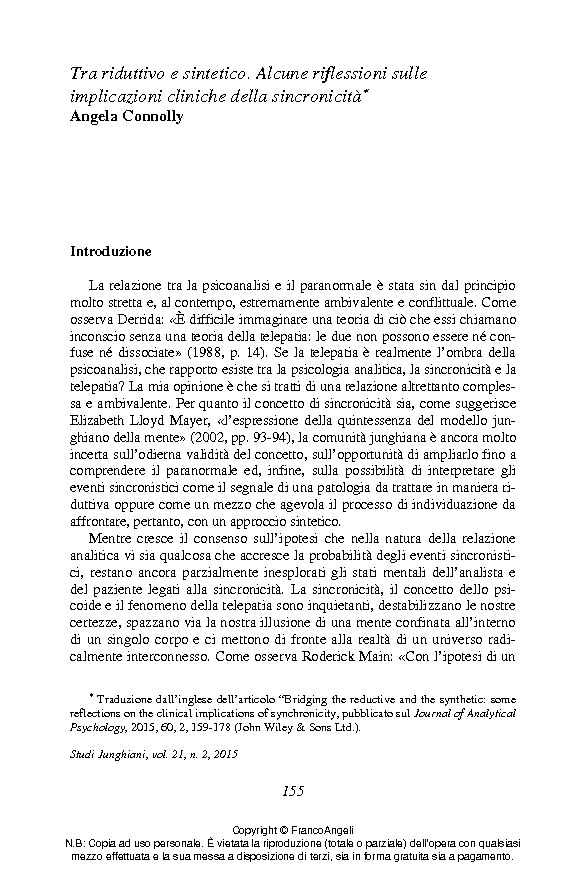Tra riduttivo e sintetico : alcune riflessioni sulle implicazioni cliniche della sincronicità
155-175 p.
Bridging the reductive and the synthetic: some reflections on the clinical implications of synchronicity.
Quando Jung introdusse i concetti di sincronicità e di inconscio psicoide, estese la psicologia analitica ad un territorio decisamente inquietante. Nonostante il precoce interesse dimostrato da Freud, i fenomeni anomali, quali la telepatia, sono diventati un soggetto tabù in psicoanalisi. Oggi, tuttavia, si osserva un interesse crescente verso il transfert e la sincronicità, così da aprire la strada a uno scambio fruttuoso tra le differenti scuole psicoanalitiche riguardo alle loro implicazioni cliniche. L'autrice propone di esaminare alcune delle ambiguità del pensiero di Jung, al fine di chiarire la definizione della sincronicità, la relazione tra le sincronicità e gli eventi parapsicologici e il loro significato clinico. Non è ancora del tutto chiaro se tali eventi debbano essere considerati normali, un mezzo per facilitare l'individuazione, oppure come il segnale di una psicopatologia del paziente o dell'analista. Altrettanta incertezza sussiste sulle caratteristiche particolari del campo intersoggettivo.
che può condurre alla sincronicità. Utilizzando la tipologia delle correlazioni mente-materia elaborata da Atmanspacher e Fach e la loro distinzione tra stati mentali acategoriali e non-categoriali, l'autrice usa due vignette cliniche per illustrare i differenti stati della mente dell'analista e dell'analizzando che possono portare alla sincronicità. In particolare si focalizza sulla relazione tra rêverie e sincronicità. [Testo dell'editore].
More than 60 years have passed since Jung wrote his groundbreaking paper on synchronicity and the psychoid unconscious, and while we are ever more aware that there is something in the analytical relationship that predisposes to synchronistic events, we are still unable to define exactly what we mean when we talk about synchronicity, just as we are still relatively uncertain as to the exact states of mind in analyst and patient that predispose to these occurrences and the meaning we should attribute to them. If, through our training and our clinical practice we are expected to be thoroughly grounded in the models of mind of either Freud or Jung, as Lloyd Mayer writes, To be thoroughly grounded in both something very few of us are - may suggest a route towards engaging the question of how the individual boundaried mind and the radically connected mind describe models of mind that can start to complement each other in new and critically important ways. In the same way, in China on the Mind, Christopher Bollas di
stinguishes between two different states of mind: one dominated by the paternal order which is causal, metonymic, diachronic, representational (privileging content over form) and dependent on words; and one under the sway of the maternal order which is metaphoric, synchronic, presentational (privileging form over content) and dependent on image. If, as Bollas writes, âÂthe maternal order has been subjected to an ongoing repression within the psychoanalytical movement' (ibid, p. 29), equally we could say that the repressed or shadow side of analytical psychology is the paternal order. I think that the image of the neglected and dying father in the first episode I mention above speaks also to this and to the need on the part of both psychoanalysis and analytical psychology to mediate and integrate these two opposite states of mind. By looking at the different states of mind that are involved in synchronicities, the hope is that we can begin to create bridges between the reductive and the synthetic approaches.
to the psyche. [Publisher's Text].
Fait partie de
Studi junghiani : rivista semestrale dell'Associazione italiana di Psicologia Analitica : 42, 2, 2015-
Articles du même numéro (disponibles individuellement)
-
Informations
Code DOI : 10.3280/JUN2015-042009
ISSN: 1971-8411
KEYWORDS
- Telepatia, sincronicità, causalità e acausalità, ruolo degli stati della mente acategoriali e non-categoriali nella sincronicità, rêverie
- Telepathy, sunchronicity, causality and acausality, role of acategorial and non-categorial states of mind in synchronicity, reverie



